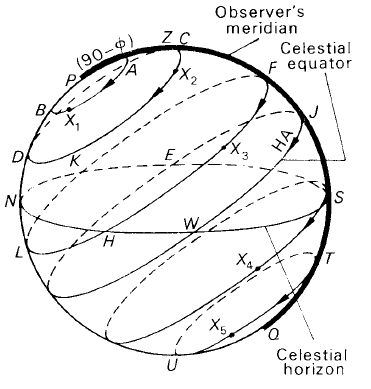


 الفيزياء الكلاسيكية
الفيزياء الكلاسيكية
 الكهربائية والمغناطيسية
الكهربائية والمغناطيسية
 علم البصريات
علم البصريات
 الفيزياء الحديثة
الفيزياء الحديثة
 النظرية النسبية
النظرية النسبية
 الفيزياء النووية
الفيزياء النووية
 فيزياء الحالة الصلبة
فيزياء الحالة الصلبة
 الليزر
الليزر
 علم الفلك
علم الفلك
 المجموعة الشمسية
المجموعة الشمسية
 الطاقة البديلة
الطاقة البديلة
 الفيزياء والعلوم الأخرى
الفيزياء والعلوم الأخرى
 مواضيع عامة في الفيزياء
مواضيع عامة في الفيزياء|
Read More
Date: 9-8-2020
Date: 11-8-2020
Date: 3-3-2016
|
The measurement of latitude and declination
Let us suppose an observer in latitude ∅ N observes a circumpolar star of declination δ, for example star X2 in figure 1.

Figure 1. Circumpolar stars.
Using a meridian circle or transit instrument , the zenith distances ZC and ZD of the star at upper and lower culmination are measured. Now
PC = PZ + ZC
i.e.
90 − δ = 90 − ∅ + ZC.
Hence,
∅ − δ = ZC. (1)
Also,
PD = ZD − ZP
or
90 − δ = ZD − 90 + ∅.
Hence,
∅ + δ = 180 − ZD. (2)
In equations (1) and (2) we have two equations in the two unknown quantities φ and δ. In principle, therefore, we can solve to obtain values of ∅ and δ.
In practice, a number of circumpolar stars are observed. Each star gives a pair of equations but only one extra unknown, namely the star’s declination. Thus, with six stars, twelve equations in seven unknowns given by the latitude and the six declinations have to be solved. This is done by means of a mathematical procedure such as the method of least squares.



|
|
|
|
التوتر والسرطان.. علماء يحذرون من "صلة خطيرة"
|
|
|
|
|
|
|
مرآة السيارة: مدى دقة عكسها للصورة الصحيحة
|
|
|
|
|
|
|
نحو شراكة وطنية متكاملة.. الأمين العام للعتبة الحسينية يبحث مع وكيل وزارة الخارجية آفاق التعاون المؤسسي
|
|
|